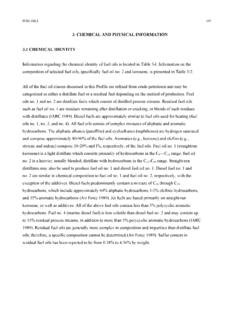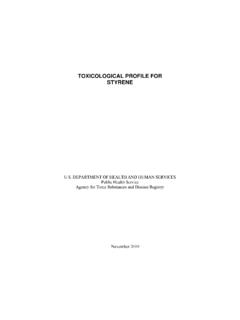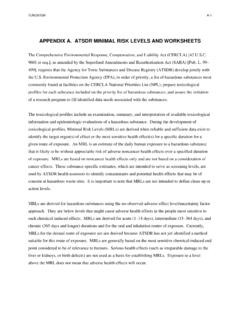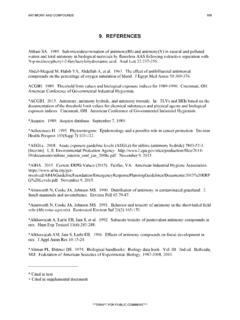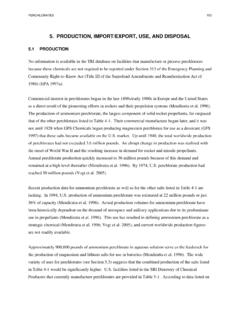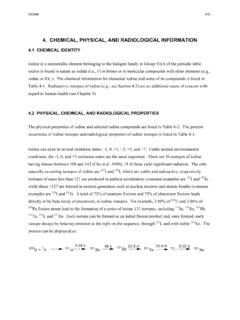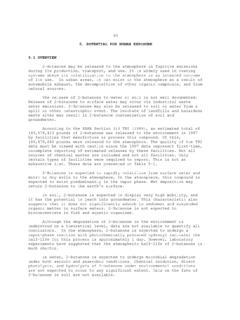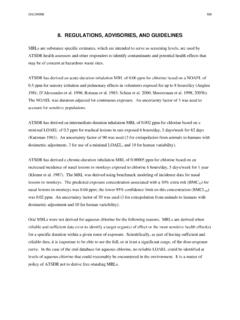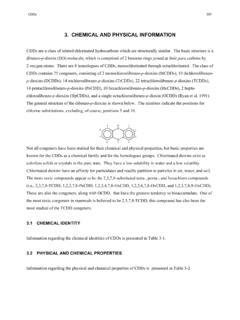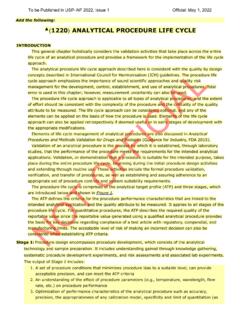Transcription of 7. ANALYTICAL METHODS
1 FLUORIDES, HYDROGEN FLUORIDE, AND FLUORINE 243. 7. ANALYTICAL METHODS . The purpose of this chapter is to describe the ANALYTICAL METHODS that are available for detecting, measuring, and/or monitoring fluorides, hydrogen fluoride, and fluorine, its metabolites, and other biomarkers of exposure and effect to fluorides, hydrogen fluoride, and fluorine. The intent is not to provide an exhaustive list of ANALYTICAL METHODS . Rather, the intention is to identify well-established METHODS that are used as the standard METHODS of analysis. Many of the ANALYTICAL METHODS used for environmental samples are the METHODS approved by federal agencies and organizations such as EPA and the National Institute for Occupational Safety and Health (NIOSH).
2 Other METHODS presented in this chapter are those that are approved by groups such as the Association of Official ANALYTICAL Chemists (AOAC) and the American Public Health Association (APHA). Additionally, ANALYTICAL METHODS are included that modify previously used METHODS to obtain lower detection limits and/or to improve accuracy and precision . Fluorine gas is too reactive to exist in biological or environmental samples. Indeed, fluorine is too reactive to be analyzed directly by conventional METHODS , but rather is quantitatively converted to chlorine gas and the latter is analyzed (Shia 1994). The METHODS discussed below are for the analysis of the fluoride ion, or in the case of gaseous acid fluorides, hydrogen fluoride.
3 The particular fluorine molecule is rarely identified. BIOLOGICAL MATERIALS. Trace levels of fluoride in biological media are determined primarily by potentiometric (ion selective electrode [ISE]) and gas chromatographic (GC) METHODS . Colorimetric METHODS are available, but are more time consuming and lack the sensitivity of the other METHODS (Kakabadse et al. 1971;. Venkateswarlu et al. 1971). Other METHODS that have been used include fluorometric, enzymatic, and proton activation analysis (Rudolph et al. 1973). The latter technique is sensitive to trace amounts of sample and requires minimal sample preparation. Urine and blood and other bodily fluids can be analyzed with a minimum of sample preparation.
4 Tissue will require ashing, digestion with acid, or even fusion with alkali to free the fluoride from its matrix. The most accurate method of sample preparation is microdiffusion techniques, such as the acid-hexamethyldisiloxane (HMDS) diffusion method by Taves (1968). These METHODS allows for the liberation of fluoride from organic or inorganic matrices (WHO. 2002). During sample preparation, the analyst must be careful to avoid sample contamination, incomplete FLUORIDES, HYDROGEN FLUORIDE, AND FLUORINE 244. 7. ANALYTICAL METHODS . release from matrices, and losses due to volatilization (NRC Canada 1971). Vogel et al. (1990) reported methodologies for sample manipulation and fluoride analysis on very small sample volumes.
5 Techniques included micropipette procedures for transferring samples, preparation of micro fluoride-selective electrodes, and METHODS for adapting standard electrodes for micro- and semi-micro volumes ( . 5 L). These techniques have been used for fluoride analysis of various biological samples, such as salvia, plaque, and tooth enamel (Vogel et al. 1990, 1992a, 1992b). Table 7-1 describes some ANALYTICAL METHODS for determining fluorides in biological materials. There is extensive literature on the ISE methodology because it is the most frequently used method for fluoride measurement in biological media. The fluoride ion selective membrane utilizes a membrane consisting of a slice of a single crystal of lanthanum fluoride that has been doped with europium (II).
6 Fluoride to improve its conductivity (Skoog et al. 1990). It has a theoretical response to changes in fluoride ion activity in the range of 100 10-6 M. It is selective to fluoride over other common anions by several orders of magnitude; only hydroxide ion causes serious interference. The pH of the solution analyzed is adjusted to approximately 5 to eliminate interference. ISE is the methodology recommended by NIOSH in Method 8308 for the determination of fluoride in urine (NIOSH 1994). Fluoride analyses using the ion selective electrode are simple, sensitive, and rapid. Recoveries are usually >90%, but this is dependent on the type of sample and the sample preparation required.
7 Sample for ISE analysis must be prepared to solubilize the fluoride in the sample. For some samples, ashing or NaOH fusion is required. A total-ionic strength adjustment buffer (TISAB) is used to adjust samples and standards to the same ionic strength and pH; this allows the concentration, rather than the activity, to be measured directly and often read directly off a meter. The pH of the buffer is about 5, a level at which F- is the predominant fluorine-containing species. The buffer contains cyclo-hexylene-dinitrilotetraacetic acid, which forms stable complexes with Fe(III) and Al(III), thus removing interferences by freeing fluoride ions from complexes with these ions (NIOSH 1994; Schamschula et al.)
8 1985; Tusl 1970). Bone fluoride levels can be measured using the ISE technique after ashing of the sample (Boivin et al. 1988). Fingernail fluoride levels can be measured using the ISE technique after nail clippings were prepared by HMDS-facilitated diffusion overnight. This sample preparation was found to quantitatively remove fluoride from the nail material (Whitford et al. 1999a). Whitford et al. (1999a) also reported that soaking the fingernail samples in deionized water for 6 hours or in a solution of ppm fluoride for 2 hours did not change the concentration of fluoride found in the nail. Recent studies have employed GC to measure fluoride concentrations in human urine and plasma (Chiba et al.
9 1982; Ikenishi and Kitagawa 1988; Ikenishi et al. 1988). In this method, derivatization and FLUORIDES, HYDROGEN FLUORIDE, AND FLUORINE 245. 7. ANALYTICAL METHODS . Table 7-1. ANALYTICAL METHODS for Determining Fluoride in Biological Materials Sample ANALYTICAL detection Percent Sample matrix Preparation method method limit recovery Reference Urine Extract with TMCS; inject organic GC 4 g/L 935 Chiba et al. 1982. phase (microwave induced plasma emission detector). Add equal volume TISAB solution ISE, mg/L 95% NIOSH 1994. NIOSH. 8308. Add TMCS toluene solution; GC >5 ng/mL No data Ikenishi et al. 1988. centrifuge; inject toluene layer Biological fluids Absorb with calcium phosphate; ISE 10 g/L 92 102% Venkateswarlu et and tissue ex- centrifuge; analyze al.
10 1971. tracts (ionic and ionizable fluoride). Saliva Resuspend in TISAB buffer; analyze ISE No data Petersson et al. 1987; Schamschula et al. 1985. Biological fluids Add TMCS toluene solution; centri- GC 5 ng/L Ikenishi et al. 1988. fuge; inject toluene layer and analyze by measuring TMFS peak height Biological Extraction from acidified sample as ISE with > ng/ No data Venkateswarlu tissues and fluorosilane; reverse extraction as hanging sample 1974. fluids fluoride ion into alkaline solution drop assembly Biological Sample pulverized to fine powder; PAA <10 ng/ No data Rudolph et al. 1973. tissues irradiate with energetic beam of sample protons; detect gamma rays emitted Decomposition of sample at 700 Colori- 1 g/sam No data Kakabadse et al.
